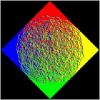well it depends on what you call an "easy way" but I guess it's quite simple.
since the normal is always upward things get easier, also you haven't mentioned if you have the coordinates of a point on the plane or not. you can't define a plane only by its normal. So lets say you have the point (x0,y0,z0) on the plane and frustum's near plane's vertical lines are L1 and L2 .
What you are trying to achieve is the points on the L1 and L2 with the y coordinates of y0. So given to ending points of L1 as (x2,y2,z2),(x1,y1,z1) and the two end of and L2 as (x3,y3,z3) and (x4y4,z4) (all of these in view space) you have the two intersection points of:
((x4 - x3)* (y4 - y0) / (y4 - y3) + x3 , y0 , (z4 - z3)* (y4 - y0) / (y4 - y3) + z3) and ((x2- x1)* (y2 - y0) / (y2 - y1) + x1 , y0 , (z2 - z1)* (y2- y0) / (y2 - y1) + z1)
its a simple interpolation don't get scared (also don't try to run  ).
).
you can do the same with the far plane's vertical line (actually they don't have to be vertical) now these points are still in view space to get them to "real space" you should simply multiply them by the inverse of the view matrix





